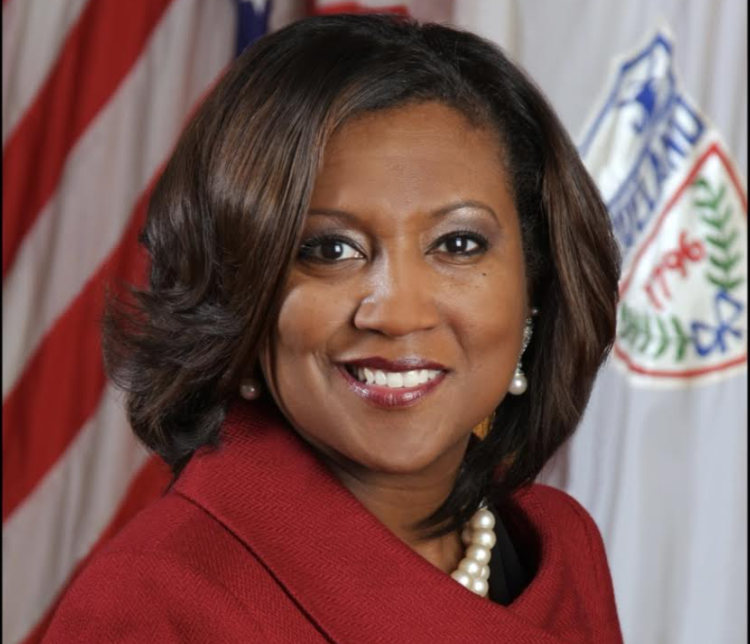Touts new manufacturing jobs, cleaner environment; acknowledges proud yesterdays, promises better tomorrows

President Biden at the Shipyards in Lorain on February 17, 2022 discussing the Bipartisan Infrastructure Bill and its benefits to the Midwest and the environment. Photo credit || Screenshot from WOIO Channel 19, which carried the President's remarks live.
President Biden came to Northeast Ohio Thursday to talk about the Bipartisan Infrastructure Law and the Restoration of the Great Lakes. He flew into Hopkins International Airport Thursday morning and proceeded by motorcade to Lorain, where he spoke at The Shipyards. He talked for about twenty minutes, acknowledging of course several public officials, including HUD secretary Marcia Fudge, Congresswoman Marcy Kaptur, whose district includes the Shipyards, and Congresswoman Shontel Brown of Warrensville Heights. The President also acknowledged Ohio’s two senators, Sherrod Brown and Rob Portman, neither of whom was present.
Here's what he said, lightly edited from a transcript provided by The White House.
• • •
“I want to talk a little about today … the treasure the Great Lakes are. They connect eight states, two nations. They provide more drinking water than any set of lakes in the world, that more than 40 million people benefit from that. They support more than 1,3000,000 jobs in manufacturing, tourism, transportation, warehousing, farming, and fishing. And they’re essential to shipping goods made in the Midwest all across the country and around the world. …
“We’re investing in [The Great Lakes] like never, ever in history. Back in 1987, an independent commission identified 43 places called “areas of concern” along the Great Lakes. They’re areas where pollution from industry, runoff from agriculture, poor wastewater treatment put the Great Lakes and everyone who depends on them at risk.
Twenty-six of these areas are in the United States side of the border. Twelve of them are in Canada. And five are shared between the United States and Canada. … For decades there was a lot of talk [about a commitment to clean them up], a lot of plans, but very little progress. That changes today.
Today, we’re announcing an investment of one billion dollars from the bipartisan Infrastructure Bill. It’s going to allow the most significant restoration of the Great Lakes in the history of the Great Lakes. We’re going to accelerate cleanup of sites across six states in the Great Lakes Basin — from Duluth, Minnesota… to Buffalo, New York, and everywhere in between.
We know these sites were dangerously polluted for decades. … Three decades ago, we made this commitment [to clean them up.] And yes, we’ve gotten a couple of them done, … Now we’re talking about cleaning up the Cuyahoga River behind the Cuyahoga Gorge Dam and in the process it passes through Cleveland, … restoring the shoreline around the Detroit River in Michigan, the St. Louis River in Minnesota and Wisconsin, the Grand Calumet River in Indiana, and so much more.
Dredging polluted sediment; restoring wetlands and habitats; making the water safer for swimming and fishing and drinking; providing habitats for wildlife and wildfowl.
The study found that every dollar we spend cleaning up the Great Lakes generates between three and four dollars in economic benefit. That’s a fact. And it’s a really good investment.
… Last month we announced over $500 million to upgrade the Soo Locks in Michigan, which connect Lake Superior and the Great Lakes. Seven thousand vessels and 90 percent of our country’s iron ore moves through these locks every single year. That ore makes nearly all the high-strength steel that goes into U.S.-made cars and appliances.
Replacing and modernizing the locks will not only create good jobs doing that, it’s going to strengthen our supply chains and get goods moving faster and reduce cost.
… For the better part of the 20th century, we used to lead the world by a significant margin because we invested in ourselves. We invested in our infrastructure, our roads, our highways, bridges, ports, airports — the arteries of the nation that allow commerce to function smoothly and move swiftly.
And we invested in our people and in opportunity. We were among the first nation to provide universal high school at the turn of the 20th century. …
And we led the world in research in and development that led to the creation of the Internet. But somewhere along the way, we took our eye off the ball. Our infrastructure used to be rated number one in the world. Today, according to the World Economic Forum, we rank number 13 in the world. China and the rest of the world is catching up and passing us.
But now, with our infrastructure law, we’re reinvesting in our economy and in our — and in our people, reclaiming our leadership, and creating millions of jobs for building a better America. …
But as we rebuild America, we’re buying American and betting on American workers.
This Buy American law makes the most significant investment in roads and bridges and highways in nearly 70 years through the infrastructure law, fixing as many as 1,300 bridges and nearly 50,000 miles of highway right here in Ohio that are in poor condition.
I’d note, parenthetically, I was — not long ago, … to visit a place in Pittsburgh, Pennsylvania where a bridge that was well over 100 feet off the ground, going over a gorge, completely collapsed at 6:30 in the morning. Thank God it was only three vehicles on it and no one died. But had it been during rush hour, kids in school buses — there would have been numerous people that would have been killed or maimed.
… American workers building these roads and bridges with American-made steel is how we’re going to do it. Jobs making high-speed Internet affordable and available to the 14 percent of households in the state of Ohio that don’t have the Internet.
We also know that Ohio has the second most lead pipes in the country. You hav e 650,000 lead pipes here in the state of Ohio. We’re going to start undoing the legacy of lead which has poisoned too many of the region’s children. That means replacing 100 percent of the lead water pipes and service lines and addressing what they call PFAS — a dangerous forever chemical — that are a threat to the drinking water here in Ohio and in other parts of America.
Every American and every child should be able to turn on a faucet and know that the water they’re drinking is clean and safe. We’re also going to create thousands of good-paying jobs in the process with union plumbers and pipefitters.
For generations, the industries that built and defined America — steel, cars, tires, paint — all of them grew and thrived right here in Ohio.
Right here on the banks of the Black River, workers built and launched 900 vessels. Freighters, tugboats, tankers, minesweepers, cruisers built right here were part of our “Arsenal of Democracy” in World War Two.
Making it in America was what this region was built on — making it in America. This region built America. It’s not hyperbole. I’m not saying that because I’m here. It’s a fact. The Midwest built America, and we’re building it again. … The fact of the matter is Wall Street didn’t build America. Ordinary, middle-class people built America, and manufacturing and unions built the middle class.
So we’re bringing manufacturing jobs back, taking supply chains back home from abroad so we have better jobs and lower prices. Since I came to office, with the help of the congressional delegation down here, we have added 375,000 manufacturing jobs in one year. In 2021, we saw the highest increase in union U.S. manufacturing jobs in nearly 30 years.
A couple of weeks ago, the CEO of Intel joined me and Senator Brown and Senator Portman … to announce at the White House — $20 billion investment in a semiconductor campus outside of Columbus, Ohio. … It’s going to create 10,000 jobs — 10,000 jobs. And by the way, 7,000 jobs constructing this massive facility and 3,000 jobs running the facility, making an average salary at that facility of $135,000 a year — blue collar workers. Pretty good money!
Manufacturing essential products that are stamped “Made in America”.
And there’s more. Just a couple of weeks ago, General Motors announced a $7 billion investment in Michigan to manufacture electric vehicles, creating 4,000 new quality jobs. … And Ford mad last year an $11 billion investment in electric vehicles, creating 11,000 new jobs.
Three weeks ago, in Western Pennsylvania, after I went to look at that bridge, the Union Pacific Railroad announced the largest purchase of American-made battery electric locomotives in history.
And because of the infrastructure law, it also delivers $7.5 billion to build a national network of 500,000 electric vehicle charging stations all across America and along our new highways. And, I might add, … installed by the IBEW [International Brotherhood of Electric Workers].
Last week a company called Tritium announced a new manufacturing facility in Lebanon, Tennessee to build 30,000 electric vehicle charging stations using American iron and American steel and American workers, creating 500 new permanent jobs in Tennessee.
We’re seeing a drumbeat of good-paying jobs unlike anything we’ve seen in our history.
But not only that. With these announcements, we’re also showing that growing the economy and creating jobs can go hand-in-hand with protecting the environment, not decimating it, meeting the moment on climate change, like our program to clean up abandoned mines and cap and plug orphaned oil and gas wells sweeping and spewing methane into the air.
Thousands of those wells and mines are right here in the Ohio River Valley, and they’re going to get paid the same amount capping them as it would cost to dig them and create those. And they’re, again, good union jobs.
And as good as these jobs are, folks digging those wells are proud what they’re about to do, because now they’re going to cap them.
The Infrastructure Law also helps us invest in a cleaner, stronger, more resilient electric grid, with 100 percent clean electric energy being generate by the year 2035.
You know all of this is going to create more good-paying jobs and make us more globally competitive and help us fight climate change and get to net zero.

L-R: U.S. Rep. Marcy Kaptur and Cleveland mayor Justin Bibb greet President Biden, HUD Secretary Marcia Fudge and EPA Administrator Michael Regan after they disembarked from Air Force One. Photo credit || Screenshot from WOIO Channel 19, which carried the President's visit live.
Let me close with this… what you’ve done here in Lorain shows what’s possible. You’ve reclaimed your waterfront; cleaned your drinking water; restored wetlands, which will help protect against storms and flooding from extreme weather and the spring thaw; and set the stage for jobs and businesses of the future.
You know, tomorrow would’ve been the birthday of one of Lorain’s most famous daughters: Toni Morrison — Nobel Prize winner, Pulitzer Prize winner.
… Tony Morrison was also the mother-in-law of the chair of my Council of Economic Advisors, Dr. Cecilia Rouse.
Toni passed away a couple of years ago. The reason I mention her is not because of her relationship to the administration, but her words that she told us to live by.
She once wrote, quote, “We got more yesterday than anybody. We need some kind of tomorrow.”
“We need some kind of tomorrow.”
Places like Lorain have a lot of proud yesterdays. Now you’re going to have some brighter tomorrows and because of all of you.
• • •• • •

















